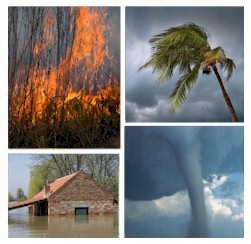|
|


Disaster Alert Systems
 This section of our technical library presents articles written about Emergency Alert Systems and Disaster Recovery definitions, terms and related information.
This section of our technical library presents articles written about Emergency Alert Systems and Disaster Recovery definitions, terms and related information.
The 911Broadcast emergency notification and alert service can deliver a large number of phone calls using a network of phone systems employing digital phone lines simultaneously. Should a disaster such as a snow storm, wild fire or flood hit your area, 911Broadcast systems can alert your community quickly providing specific instructions if an evacuation is required.
This service is available using our emergency broadcasting systems. If a dangerous chemical spill occurs in your community, you can target specific areas to call. If a severe snow storm hits your area, your community can be notified of school closings or event cancellations.
Emergency Alert Technology for Canada
The following is an extract from the article "Emergency Alert Canada" by Brett W. Mann.
"There are surely few fields where the need to adopt the most recent, effective technologies is as urgent as in the realm of emergency public communication. Advances in accuracy and early detection of severe weather conditions create a concomitant need to issue timely, authoritative and informative warnings.
Computerized communications now permit simultaneous alerts to a wide range of broadcasting agencies. Several current Canadian projects are exploring ways to optimize emergency communications through improved government-private sector coordination and use of emerging technologies.
Warnings on TV
WeatherAlert is a public warning pilot project initiated in the Greater Toronto Area in February, 1997. Environment Canada, working with Rogers Cablesystems and local broadcasters, is launching the made-for-television service to alert residents of the Halton, Peel, York, Durham and Metro Toronto regions of impending severe weather systems.
Elizabeth Adamson, Environment Canada's project manager for WeatherAlert in Toronto reports that the service will take the form of a TV "crawler" scrolling across the bottom of television screens. A sample message might read "ENVIRONMENT CANADA HAS ISSUED A TORNADO WARNING FOR HALTON-PEEL." WeatherAlert messages will be triggered by designated events -- tornadoes, severe thunderstorms or winds, blizzards, heavy rain, freezing rain or snow and snowsqualls.
"It is very difficult to go through the regular dissemination systems and get that warning to people before the storm hits."
"The Americans have been using this crawler format for some time," says Ms. Adamson, "but this will be the first crawler message generated specifically for TV by Environment Canada." The warning does not contain a lot of information, but is intended to alert the public that there is impending severe weather in the near future -- from a few minutes to up to a two-hour range.
Ms. Adamson expects that the system will be most useful during severe summer weather. "We know that there are going to be thunderstorms on a certain day, but until they actually start to develop in the afternoon, we don't know the specific areas where they will be. What this alert system allows us to do, in a few minutes, is to get to TV viewers, giving them a longer lead time. It is very difficult to go through the regular dissemination systems and get that warning to people before the storm hits," she explains.
While the devastating 1985 Barrie tornado offers a vivid example of the type of weather hazards WeatherAlert was designed for, winter warnings can be critical as well, particularly when amended warnings are required (when a severe storm arrives earlier than expected).
"There are two systems being tested in the pilot project," reports Adamson, "one is a cable system where a box installed at the cable's head (feeder) introduces a crawler message over the signals of participating broadcasters. Most of these are specialty channels."
The other system that is being tested is run by local broadcasters. Three are involved in the test -- CBC in Toronto, CFMT, and CTV (Daytime Broadcasting) are running the crawler. They have a PC-based system which picks up the signal from Environment Canada's Weathercopy transmission, and inserts the crawler message on their own signal.
"We have another partner in this," notes Ms. Adamson, "Pelmorex, the MétéoMédia Weather Channel people. We send the signal into Pelmorex's main hub in Montreal and they direct it out to Rogers. It's an automatic system where, once we release it, it appears on the broadcast signal at the other end without human intervention."
Ms. Adamson hopes to see the TV alert system refined and eventually made operational across Canada...."
To view the entire article, please contact Mr. Mann. Brett W. Mann is a freelance writer based in Belleville, Ontario

Emergency Phone Dialers
DSC now offers an affordable and expandable emergency phone dialer and voice broadcasting (VB) analog phone system. This 4 line auto dialing system includes our voice message and broadcast Wizard software or comes optionally with our comprehensive software development toolkit.
You can program your own system or we can provide you with a custom message broadcasting application. These applications can be easily ported to our digital T1 phone system (PACER) when your call volume requires a larger system.
This entry level system can be easily expanded by adding agent lines and software to support a small response center including inbound emergency call handling and normal outbound dialing.
DSC provides voice broadcast software including our VB wizard development tool for creating custom phone applications. This wizard guides you through each step when defining your VB applications. Informational phone applications can be developed quickly. Simply record your phone prompts and fill in the blanks.
|
|
|




 This section of our technical library presents articles written about Emergency Alert Systems and Disaster Recovery definitions, terms and related information.
This section of our technical library presents articles written about Emergency Alert Systems and Disaster Recovery definitions, terms and related information.

